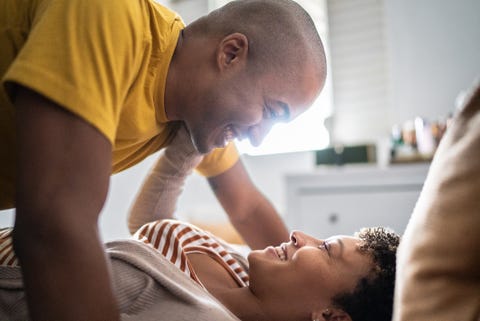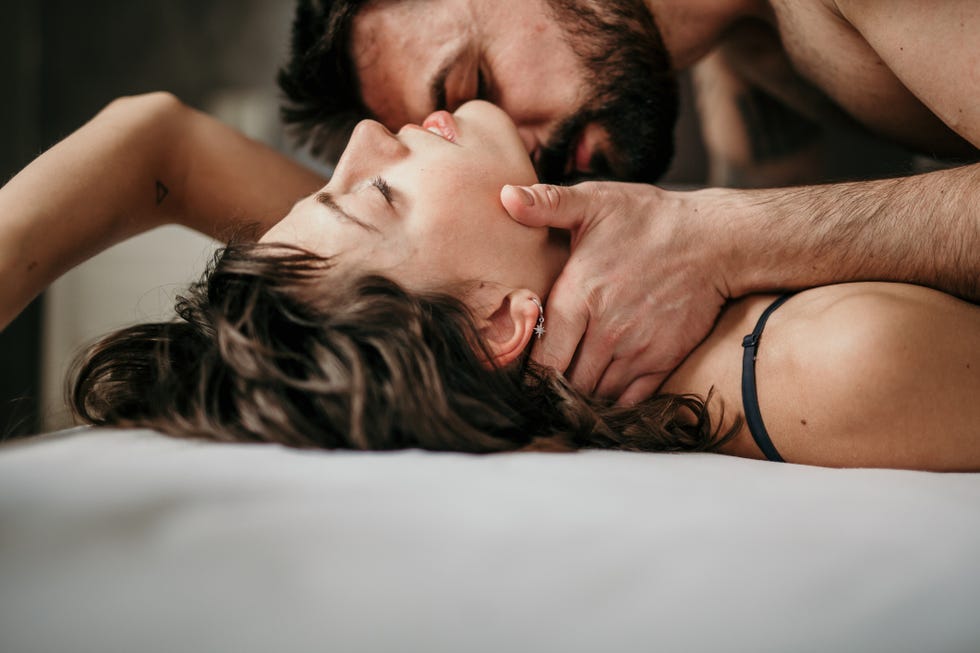
What is the G-spot? Where is the G-spot? Does the G-spot even exist?
These questions have puzzled sex researchers and sex-havers for decades, and the answers evolve every year. In 2012, a scientific review came to the conclusion that there isn’t much anatomical proof that every person with a vulva has a G-spot. After that, studies began speculating that the G-spot does exist, but it isn’t so much its own entity as it is likely an extension of the clitoris. The clitoris extends up to five inches inside the body, which is why researchers are beginning to conceptualize the G-spot as not existing independently, but rather, as an entity deeply intertwined with other parts of the sexual anatomy.
The relationship between three structures—the clitoris, urethral sponge, and anterior vaginal wall—has led researchers to identify a clitourethrovaginal (CUV) complex. A groundbreaking article published in Nature Reviews in 2014 posited that when the CUV is “properly stimulated during penetration, [it] could induce orgasmic responses.”
But wait—there’s more. In 2022, an editorial published in the Sexual Medicine Reviews Journal explained that the G-spot isn’t actually made up of three structures—it’s more like five: the clitoral crura; the clitoral bulb; the peri-urethral glands; the urethra; and the anterior vaginal wall. As long as that number keeps growing, we should probably acknowledge that the G-spot isn’t a “spot” at all. It’s a zone.
“We suggest the current term ‘G-spot’ is misleading and therefore inappropriate,” the authors wrote. “The five erotogenic regions of the anterior vaginal wall can be more accurately and appropriately termed the Gräfenberg Zone or G-zone.”

Serg MyshkovskyGetty Images
No matter what you call it, the G-spot is a pleasure center, and some vulva-owners can achieve an orgasm by stimulating it from inside the vagina.
“Sex researchers who focus on neurology have found that there are four nerves that innervate the genitals—the pelvic, pudendal, vagus, and hypogastric—and each take a different pathway through the body,” explains international sex hacker and educator Kenneth Play. “The pudendal nerve that innervates the clitoris goes directly up the spine, resulting in a more localized sensation, whereas the vagus nerve that innervates the deepest area of the vagina, travels through the body in a meandering fashion, resulting in a more radiating, full-body orgasm.”
Still, many vulva-owners aren’t convinced they have a G-spot. When British researchers asked 1,800 vulva-owners if they believed they had a G-spot, only 56% said yes, which isn’t very encouraging for guys trying to strike orgasm gold with their fingertips. Nevertheless, that doesn’t mean you shouldn’t try (unless your partner tells you that they prefer you keep things to their external clitoris).
And regardless of whether your partner can have G-spot-induced orgasms, if you know the right way to go about looking for the G-spot, your partner will enjoy the hunt, says Emily Morse, host of the podcast “Sex with Emily.” Here’s how to find and stimulate the G-spot.
Make sure to warm up first.
First and foremost, make sure your hands are clean and your fingernails are trimmed, because you’re going to be putting them in a very sensitive place, Morse says. Due to its tucked-away location, “fingers are usually most effective at finding and stimulating the G-spot,” she says.
Like anything else related to sex, foreplay is paramount, Morse stresses. Focus on kissing and caressing your partner’s lips, breasts, butt, and other non-genital hot spots for several minutes before getting down to business. “The G-spot is composed of tissue that swells when it becomes aroused,” Morse says. “If your partner’s already turned on, it will be much easier for you to find it and go about pleasing them.”
Even if your partner is moist from foreplay, Morse notes that a few drops of lubricant might make things more comfortable for them.
Your partner won’t be able to fully enjoy the experience and reach orgasm “without a certain level of focus and calm on their part,” Play adds. “Facilitating an environment of trust and attention to sensation is essential. This can mean creating an organized, calming bedroom space for play, being focused and present with your lover, or even coaching them to focus on the sensations they’re feeling.”

FG TradeGetty Images
How to find their G-spot:
Before we get into how to find the G-spot, let’s acknowledge the man who found it “first.” The G-spot was initially described in the 1940s by German researcher Ernst Gräfenberg, after whom the spot is named. (The G does indeed stand for Gräfenberg, although we wouldn’t recommend asking if you’re hitting your partner’s Gräfenberg Spot while getting hot and heavy in the bedroom.)
Gräfenberg “discovering” the G-spot was a lot like Christopher Columbus “discovering” America—he identified something that existed long before he got there. When you start exploring your partner’s vagina, remember that they know a lot more about their body than you do, and they can probably show you where their G-spot is. If not, Morse offers a set of directions: “It’s about two inches inside of the vagina, on the top side of the vaginal wall.”
If your partner is on their back and you insert a finger with your palm facing the ceiling, the “top side” of their vagina is the spot you’ll touch by curling your finger in a come-hither motion, almost like you’re trying to stroke their belly button from the inside. If you’re having trouble, have your partner draw their knees back toward their chest to give your fingers better access, Morse says. “You’ll know you found it because it will feel like a bean-shaped bump and maybe more textured than the surrounding tissue,” she adds.
If you don’t find a spongy texture right away, feel around. Every vulva-owner’s body is different, and some G-spots might be off to the side. Marla Renee Stewart, Sexologist and Sexual Strategist at Velvet Lips Sex Education, offers this tip: If you think of the anterior vaginal wall as a clock, the G-spot can be anywhere between ten o’clock and two o’clock.
How to stimulate their G-spot:
Now that you know where the G-spot is, how do you stimulate it? Just as you wouldn’t forcefully jam your whole penis into your partner in a single movement, you should work your finger in slowly and softly. “Do not thrust vigorously,” Morse warns. “Your partner is not a change purse and you are not searching for quarters.”
Once they seem comfortable with your finger inside of them, use that same curling motion to softly massage the top of their vagina with the pad of your finger. Stroke the G-spot in a rhythmic motion, trying different speeds and amounts of pressure until you’ve found the one they most enjoy. “If your partner isn’t giving you feedback, don’t pick up the pace or increase the pressure,” Morse stresses. “Ask them how it feels, and adjust your moves accordingly.”
“Consistency and pressure tend to be good keys to sexual success,” Stewart says.
How to take G-spot stimulation to the next level:
If you’ve successfully worked your way to the G-spot and your partner is into it, Morse recommends using your free hand to gently press on their belly, just above the top line of their pubic hair. Soft pressure on the outside can help stimulate their G-spot even more.
Stewart recommends using toys. A vibrator against your partner’s clitoris will provide consistent external stimulation while your fingers are inside them, or you can opt for an internal toy instead. “Stainless steel toys are great for friction and providing pressure on the [G-spot],” Stewart explains. A favorite stainless steel toy among vulva-owners is the Njoy Pure Wand. Its curved shape is perfect for G-spot access.
If you want to stimulate your partner’s G-spot during penis-in-vagina intercourse, rear-entry positions like doggy style are especially good at stimulating their G-spot, Morse says. “Make sure your partner’s on all fours with their back arched slightly, as opposed to lying with their head on the bed. Try lifting their hips and thrusting in a downward motion so your penis can more easily rub the front wall of their vagina.”
Stewart recommends positions that put your partner in control. Cowgirl and reverse cowgirl allow your partner to be in charge of the penetration speed and angle, while the lotus position—which is when both partners sit face-to-face and wrap their arms and legs around each other—lets your partner regulate the pressure by leaning forward or leaning back.
Don’t be surprised if your partner ejaculates or “squirts.” Consistent G-spot stimulation causes some vulva-owners to release fluid from the Skene’s glands through the urethra, and the sensation can be intensely pleasurable. If you know your partner tends to squirt from penetration, throw down a towel before you get down to business. That way, your partner won’t have to worry about soaking the sheets, and they can stay present in their body and enjoy whatever sensations arise.
No matter how you stimulate the G-spot, experiment and see exactly where your partner’s most pleasurable areas are. “In terms of pressure, once you find the right spot, a general rule of thumb is to build more pressure slowly until it is slightly too much, and then decrease it until it is just below ‘too much,’” Play says.
Now go have fun exploring.
The Editors of Men’s Health
The editors of Men’s Health are your personal conduit to the top experts in the world on all things important to men: health, fitness, style, sex, and more.
Zachary Zane
Zachary Zane is a Brooklyn-based writer, speaker, and activist whose work focuses on lifestyle, sexuality, and culture. He was formerly the digital associate editor at OUT Magazine and currently has a queer cannabis column, Puff Puff YASS, at Civilized.
Ro White
Ro White is a Chicago-based writer, sex educator, and Autostraddle’s Sex & Dating Editor.
This content is created and maintained by a third party, and imported onto this page to help users provide their email addresses. You may be able to find more information about this and similar content at piano.io
